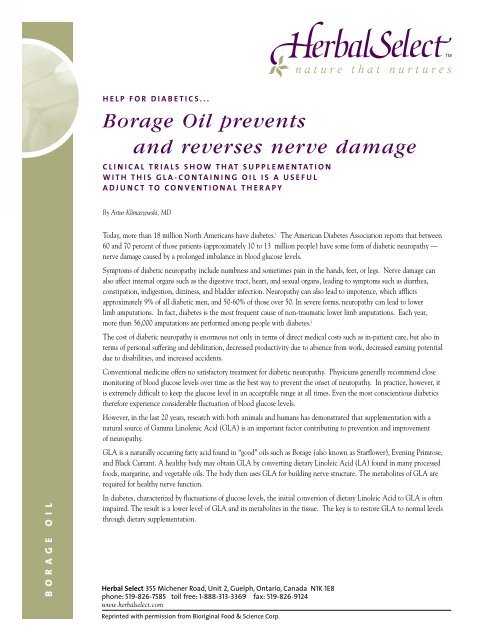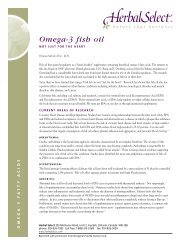Borage Oil prevents and reverses nerve damage - Herbal Select
Borage Oil prevents and reverses nerve damage - Herbal Select
Borage Oil prevents and reverses nerve damage - Herbal Select
- No tags were found...
You also want an ePaper? Increase the reach of your titles
YUMPU automatically turns print PDFs into web optimized ePapers that Google loves.
HELP FOR DIABETICS...<strong>Borage</strong> <strong>Oil</strong> <strong>prevents</strong><strong>and</strong> <strong>reverses</strong> <strong>nerve</strong> <strong>damage</strong>CLINICAL TRIALS SHOW THAT SUPPLEMENTATIONWITH THIS GLA-CONTAINING OIL IS A USEFULADJUNCT TO CONVENTIONAL THERAPYBy Artur Klimaszewski, MDB O R A G E O I LToday, more than 18 million North Americans have diabetes. 1 The American Diabetes Association reports that between60 <strong>and</strong> 70 percent of those patients (approximately 10 to 13 million people) have some form of diabetic neuropathy —<strong>nerve</strong> <strong>damage</strong> caused by a prolonged imbalance in blood glucose levels.Symptoms of diabetic neuropathy include numbness <strong>and</strong> sometimes pain in the h<strong>and</strong>s, feet, or legs. Nerve <strong>damage</strong> canalso affect internal organs such as the digestive tract, heart, <strong>and</strong> sexual organs, leading to symptoms such as diarrhea,constipation, indigestion, dizziness, <strong>and</strong> bladder infection. Neuropathy can also lead to impotence, which afflictsapproximately 9% of all diabetic men, <strong>and</strong> 50-60% of those over 50. In severe forms, neuropathy can lead to lowerlimb amputations. In fact, diabetes is the most frequent cause of non-traumatic lower limb amputations. Each year,more than 56,000 amputations are performed among people with diabetes. 2The cost of diabetic neuropathy is enormous not only in terms of direct medical costs such as in-patient care, but also interms of personal suffering <strong>and</strong> debilitation, decreased productivity due to absence from work, decreased earning potentialdue to disabilities, <strong>and</strong> increased accidents.Conventional medicine offers no satisfactory treatment for diabetic neuropathy. Physicians generally recommend closemonitoring of blood glucose levels over time as the best way to prevent the onset of neuropathy. In practice, however, itis extremely difficult to keep the glucose level in an acceptable range at all times. Even the most conscientious diabeticstherefore experience considerable fluctuation of blood glucose levels.However, in the last 20 years, research with both animals <strong>and</strong> humans has demonstrated that supplementation with anatural source of Gamma Linolenic Acid (GLA) is an important factor contributing to prevention <strong>and</strong> improvementof neuropathy.GLA is a naturally occurring fatty acid found in “good” oils such as <strong>Borage</strong> (also known as Starflower), Evening Primrose,<strong>and</strong> Black Currant. A healthy body may obtain GLA by converting dietary Linoleic Acid (LA) found in many processedfoods, margarine, <strong>and</strong> vegetable oils. The body then uses GLA for building <strong>nerve</strong> structure. The metabolites of GLA arerequired for healthy <strong>nerve</strong> function.In diabetes, characterized by fluctuations of glucose levels, the initial conversion of dietary Linoleic Acid to GLA is oftenimpaired. The result is a lower level of GLA <strong>and</strong> its metabolites in the tissue. The key is to restore GLA to normal levelsthrough dietary supplementation.<strong>Herbal</strong> <strong>Select</strong> 355 Michener Road, Unit 2, Guelph, Ontario, Canada N1K 1E8phone: 519-826-7585 toll free: 1-888-313-3369 fax: 519-826-9124www.herbalselect.comReprinted with permission from Bioriginal Food & Science Corp.
B O R A G E O I LTHE EFFECTS OF GLA ON DIABETIC NEUROPATHYTo date, there have been three placebo-controlled human studies on the use of GLA in diabetic patients. The studiesconsistently concluded that GLA has a beneficial effect on the course of diabetic neuropathy, as measured by peripheral<strong>nerve</strong> function, <strong>nerve</strong> conduction velocity, <strong>nerve</strong> capillary blood flow, <strong>and</strong> other factors.Human trials began in 1986, when a group of researchers conducted a double-blind, placebo-controlled study with 22patients. 3 The treatment group received 360 mg of GLA per day for 6 months. All tested variables improved in thetreatment group <strong>and</strong> worsened in the placebo group.These results sparked further scientific interest in the subject. Two subsequent multicenter studies, including morethan 400 patients, obtained consistently positive results. The first included 111 patients in 7 centers, 4 while the secondincluded 293 patients in 10 centers. 5 The patients received 480 mg of GLA per day for one year. The researchersmeasured 16 parameters in all, including <strong>nerve</strong> conduction strength <strong>and</strong> speed, hot <strong>and</strong> cold thresholds, sensation,reflexes, <strong>and</strong> muscle strength.After a full year of treatment, all 16 parameters showed favorable improvement as compared to the placebo group.Laboratory research indicates that recovery of patients may be even more complete when GLA is used in conjunctionwith anti-oxidants. 6GLA will not eliminate the need to monitor glucose levels - but it is, without question, a helpful adjunct to conventionaltreatment of diabetic neuropathy.GLA PREVENTS NERVE DAMAGE ANDIMPROVES NERVE FUNCTION IN DIABETICS4 m/sChangein <strong>nerve</strong>conductionspeed4 m/s3 months6 months12 monthsGLAtreatmentgroupPlacebotreatmentgroupAdapted from Diabetes Care, January 1993GETTING THE GLA YOU NEEDThe best source of GLA is <strong>Borage</strong> (or Starflower) <strong>Oil</strong>, which contains up to 23% GLA. Evening Primrose <strong>Oil</strong> (8-10%GLA) <strong>and</strong> Black Currant <strong>Oil</strong> (15-17% GLA) are other sources of GLA. Because of the higher concentration of GLA in<strong>Borage</strong>, a patient may consume fewer capsules overall to achieve the required dosage. This allows the patient to consumethe least amount of supplemental calories <strong>and</strong> fat possible, which is of the utmost importance in diabetes. It also makes<strong>Borage</strong> <strong>Oil</strong> the most economical source of GLA.Clinical research indicates that a dosage of 500 mg GLA per day is effective - that’s only 2 grams of <strong>Borage</strong> <strong>Oil</strong> daily.Studies have shown that <strong>Borage</strong> <strong>Oil</strong> is safe <strong>and</strong> non-toxic, even in large amounts.Artur Klimaszewski is an MD with Bioriginal Food & Science Corp., Saskatoon, Canada.He is devoted to research in the field of Essential Fatty Acids.<strong>Herbal</strong> <strong>Select</strong> 355 Michener Road, Unit 2, Guelph, Ontario, Canada N1K 1E8phone: 519-826-7585 toll free: 1-888-313-3369 fax: 519-826-9124www.herbalselect.comReprinted with permission from Bioriginal Food & Science Corp.
B O R A G E O I LREFERENCES:1. Figures compiled from the American Diabetes Association <strong>and</strong> the Canadian Diabetes Association, 1998.2. American Diabetes Association, 1999.3. Jamal GA, et al. Gamma Linolenic acid in diabetic neuropathy. Lancet, Vol. 10. p. 1098 (1986).4. The Gamma Linolenic Acid Multicenter Trial Group. Treatment of Diabetic Neuropathy with Gamma Linolenic Acid,Diabetes Care, Vol. 16, No. 1, pp 8-15 (1993).5. Unpublished research by the Gamma Linolenic Acid Multicenter Trial Group. Reported by Horrobin, David. EssentialFatty Acids in the Management of Impaired Nerve Function in Diabetes, Diabetes, Vol. 46, Suppl. 2, pp S90-93 (1997).6. Cameron, Norman <strong>and</strong> Mary Cotter. Metabolic <strong>and</strong> Vascular Factors in the Pathogenesis of Diabetic Neuropathy,Diabetes, Vol. 46, Suppl. 2, pp S31-S37 (1997).October 1999© Copyright Bioriginal Food & Science Corp.May be reprinted in whole or in part with written permission from the corporation.Address: 102 Melville Street, Saskatoon, Saskatchewan, CANADA S7J 0R1.Phone: (306) 975-1166 Fax: (306) 242-3829Website: www.bioriginal.comThis information is provided in good faith as educational material. It is the customer’s responsibility to check the suitability of the materialunder FDA (DSHEA), HPB, <strong>and</strong>/or any other rules regarding the use of this material. Bioriginal is not responsible for compliance to variousrules regarding the use of this literature as promotional material.<strong>Herbal</strong> <strong>Select</strong> 355 Michener Road, Unit 2, Guelph, Ontario, Canada N1K 1E8phone: 519-826-7585 toll free: 1-888-313-3369 fax: 519-826-9124www.herbalselect.comReprinted with permission from Bioriginal Food & Science Corp.





